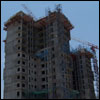‘We’ll see more and more high-rises in a few years’
 Gautam Thapar, Director,
Gautam Thapar, Director,
Thapar Group
I am of the opinion that the infrastructural ecosystem in India is presumably weak to sustain such high-rise buildings as we see in other counties like France, England, USA and Japan, to name a few. However, steps are being taken to bring in reforms that are conducive to such real estate projects. In a span of five-six years from now, we hope to see more and more high-rises. FSI limits in India are comparatively low vis-à-vis other parts of the world. Besides, cost of construction is also a major deterrent in India.
High-flung stories cost more in terms of construction; however, sale prices plummet when it comes to home-buyer preference and demand. The benefits of living in upper floor of a high-rise are less pollution, better air quality, no sound, better view etc., which is why world over the higher you go, the higher the price of apartment. But, in Delhi, for some reason people are scared to live on higher floors, basically due to the trend of plotted developments in Delhi. But with the younger generation buying their own home, this trend will soon change.
 ‘High-rises are the only solution in metros’
‘High-rises are the only solution in metros’
— Rohit Poddar, Managing Director, Poddar Developers Ltd.
High-rise buildings (as compared to low rise) are obviously the only solution in a densely populated mega-polis such as Mumbai which faces acute land shortage, where additional ground area can be made available to address the need of drastically better public infrastructure like roads, mass urban transport systems, public spaces, gardens, museums etc.
The challenges lie primarily in three areas – availability of land and clear land title; the plethora of permissions required for approvals; and the increasing number of PILs faced by development companies.
Affordable housing in the metros currently require an ‘integrated satellite townships’ concept with schools, healthcare, amenities, utilities, good quality first time right construction technology, low maintenance and high connectivity to the workplace.
Additionally, land has to be comparatively inexpensive. Low-rise constructions (G+3) for such projects make it more affordable for the customer and developer initially but as land prices sharply rise subsequently, the option of increasing the FSI and thereby the height of the building, is a practical solution.
 ‘Our infrastructure cannot sustain high-rises’
‘Our infrastructure cannot sustain high-rises’
Sandeep Katiyar, CEO, Century 21
India is still far from the rational thinking of creating a holistic society where you create a better infrastructure and also keep residential spaces for citizens which is closer to a city’s business centres. Our infrastructure is so weak that it cannot sustain high-rise structures as we see in regions like Singapore, Hong Kong, China or US. A few challenges are as follows:
* Even in a city like Delhi, our approved FSI is very low as compared to other similarly capable cities, in terms of infrastructure. The scenario is not the same in other parts of the world, as aforementioned.
* Cost of construction drastically burgeons when it moves beyond 10-12 stories where you have to comply with all the fire and safety norms applicable for high-rise buildings. Cost increases further once it goes beyond 22-24 stories when you need to use specialised technologies. As a corollary, it has to be compensated by a higher allowed FSI so that the developer can create a right price product.
 ‘We aim to change the skyline with high-rises’
‘We aim to change the skyline with high-rises’
— Srinivasan Gopalan, CFO & COO, The Wadhwa Group
High-rise buildings come up as logical and the most practical solutions in any developing city that has scarcity of land. Across the globe cities like Hong Kong, Shanghai and Dubai are constructing high-rises which are being considered the need of the hour; as the only solution for developing countries is to grow vertically. This is very true for Mumbai as well and at The Wadhwa Group, we are aiming to change the skyline of our city with a mass expansion of our high-rise projects.
Of course, the current challenges for this are the norms of today which need to evolve along with progress and economic development. Issues like low FSI, relevant green building regulations and clearances by the authorities are major concerns at the moment. We believe that certain considerations and permissions need to be treated basis the requirement and need. The location of the area being developed would also need to be considered.












Solicon Energy Systems
We,Solar Water Heater Menufacturing And All Renewabale Energy Productds.